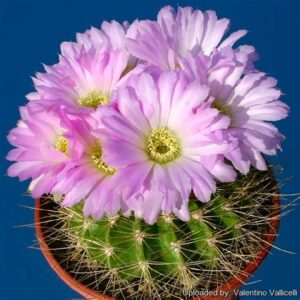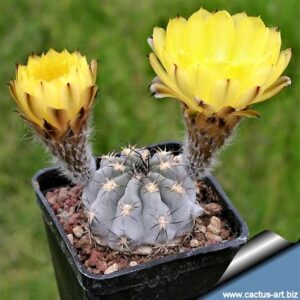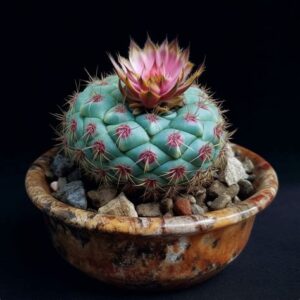Acanthocalycium thionanthum var. brevispinum, often affectionately dubbed the “Tequila Cactus,” captivates enthusiasts with its unique appearance and undemanding nature. This intriguing variety of cactus is distinguished by its silky ribbed texture and short, robust spines that evoke curiosity and charm. Ideal for both novices and seasoned collectors, this guide delves into the essential aspects of growing and caring for Acanthocalycium thionanthum var. brevispinum, shedding light on its aesthetic appeal and the characteristics that set it apart in the vast world of cacti.
By understanding its native habitat, morphology, and proper cultivation techniques, hobbyists can foster a flourishing specimen that not only enhances their garden but also serves as a conversation starter among fellow succulent aficionados.
Origin and Habitat: Unraveling the Native Enigma
The Acanthocalycium genus finds its roots in the semi-arid regions of South America, particularly thriving in Argentina. This location influences the plant’s growth habits and requirements, shaping its compatibility with various environments. Specifically, Acanthocalycium thionanthum var. brevispinum flourishes in rocky, well-drained soils where it receives substantial sunlight but is also adapted to withstand the occasional shade.
In its native habitat, this species forms clusters that create an almost ethereal landscape, painted with shades of green and cream as the plants bloom. The ability to grow in arid conditions leads to intriguing survival strategies, making it particularly resilient and adaptable to diverse settings. Understanding these natural conditions can help gardeners mimic its environment, ensuring healthy growth and development.
Distinctive Features: The Allure of Brevispinum
Acanthocalycium thionanthum var. brevispinum is not merely another cactus; it possesses distinctive features that elevate its status in the botanical realm. The most striking aspect is its short and stout spines, which are considerably thicker than those found on related species. This variation enhances its visual appeal, lending an almost protective aura to the plant as it grows.
The plant’s body is globose and creates an awe-inspiring spectacle when it matures. With a diameter that can reach up to 12 centimeters, the deep green skin is adorned with ribbing that varies from angular to rounded, presenting a tactile feast for plant lovers. When flowering, this variety showcases stunning blooms that emerge in vibrant hues—from shimmering yellows to deep oranges—that contrast beautifully with the skin’s lush greenery. Each flower can bloom for several days, creating a mesmerizing display.
This interplay of spines, color, and form invites observers to appreciate the intricate beauty of this cactus, leading many to include it as a centerpiece in succulent arrangements or as an eye-catching addition to rock gardens.
Soil and Potting: The Foundation of Successful Cultivation
The soil composition is critical for Acanthocalycium thionanthum var. brevispinum. An ideal potting mix should embody excellent drainage, allowing excess moisture to escape and preventing root rot—a common pitfall in cactus cultivation. A blend of standard potting soil with perlite, pumice, or coarse sand can create an optimal environment. This mix mimics the native rocky soils and promotes healthy root development.
When potting, it is essential to select a container with adequate drainage holes. Clay pots are favored due to their breathability, allowing moisture to escape while maintaining a balanced environment for the roots. Choose a pot slightly larger than the root ball to give the plant room to grow without overwhelming it with excess soil.
Watering: The Balancing Act of Hydration
Acanthocalycium thionanthum var. brevispinum has specific watering needs that fluctuate between its growing season and dormancy periods. Water during the growing season—typically from spring to early autumn—when the temperatures rise and the plant shows signs of growth. At this time, a robust watering schedule is recommended, allowing the soil to dry out between irrigation sessions. This method encourages deep root growth and enhances overall vitality.
During the dormancy phase in winter, water should be reduced significantly. Overwatering during this period can lead to disastrous consequences, such as root rot and overall plant stress. A good rule of thumb is to check the soil moisture before watering. If the top inch of soil feels dry, it’s time for a drink; otherwise, it is best to wait.
Light Requirements: Harnessing the Power of the Sun
Light plays an indispensable role in the growth of Acanthocalycium thionanthum var. brevispinum. This cactus thrives in bright, indirect sunlight but can also tolerate several hours of direct sun exposure each day. Finding the right balance is crucial; too little sunlight can result in etiolation, causing the plant to stretch awkwardly towards the light source, while excessive direct sunlight can scorch its delicate skin.
For indoor cultivators, placing the cactus near a south-or-west-facing window provides ideal conditions. If outdoor growing is preferred, situating the plant in a location that receives morning sun and afternoon shade can yield remarkable results. This approach allows the plant to absorb essential light without suffering from harsh midday rays.
Fertilization: Nourishing Growth and Blooms
While Acanthocalycium thionanthum var. brevispinum is relatively low-maintenance, regular fertilization can significantly boost overall health and promote vibrant blooms. During the growing season, apply a diluted cactus fertilizer every four to six weeks. Choosing a fertilizer with a balanced N-P-K ratio ensures that the plant receives the nutrients necessary for robust growth.
In the dormant season, feeding should be halted altogether, allowing the plant to focus its energy on resting and conserving resources. Excessive fertilization at this time can lead to detrimental growth patterns, so it is best to check nutrient levels and adhere to a careful feeding schedule.
Pest Management: Cultivating a Healthy Ecosystem
Like all cacti, Acanthocalycium thionanthum var. brevispinum can be susceptible to pests such as mealybugs, spider mites, and aphids. Regularly inspecting the plant for signs of infestation is essential for maintaining a healthy specimen. Natural pest control methods can be effective—using a diluted solution of neem oil can deter pests without harming the plant.
Maintaining good air circulation around the cactus and ensuring adequate lighting can also reduce the risk of pest infestations. If an outbreak occurs, it is an opportunity to reassess care routines to promote a healthier ecosystem.
Conclusion: Embracing the Cactus Journey
Acanthocalycium thionanthum var. brevispinum offers a remarkably rewarding experience for those drawn to cacti. From its enchanting appearance to its straightforward care requirements, this cactus reveals the exquisite beauty and unique adaptability of nature. By mimicking its native environment and adhering to best cultivation practices, plant enthusiasts can cultivate a thriving specimen that serves as a testament to their dedication and passion for the botanical arts.
Engaging with this species not only fosters a deeper understanding of plant care but also enhances the aesthetic appeal of any garden or indoor space. Invite this captivating cactus into your collection, and witness the allure of the “Tequila Cactus” unfold before your eyes.





Leave a Comment